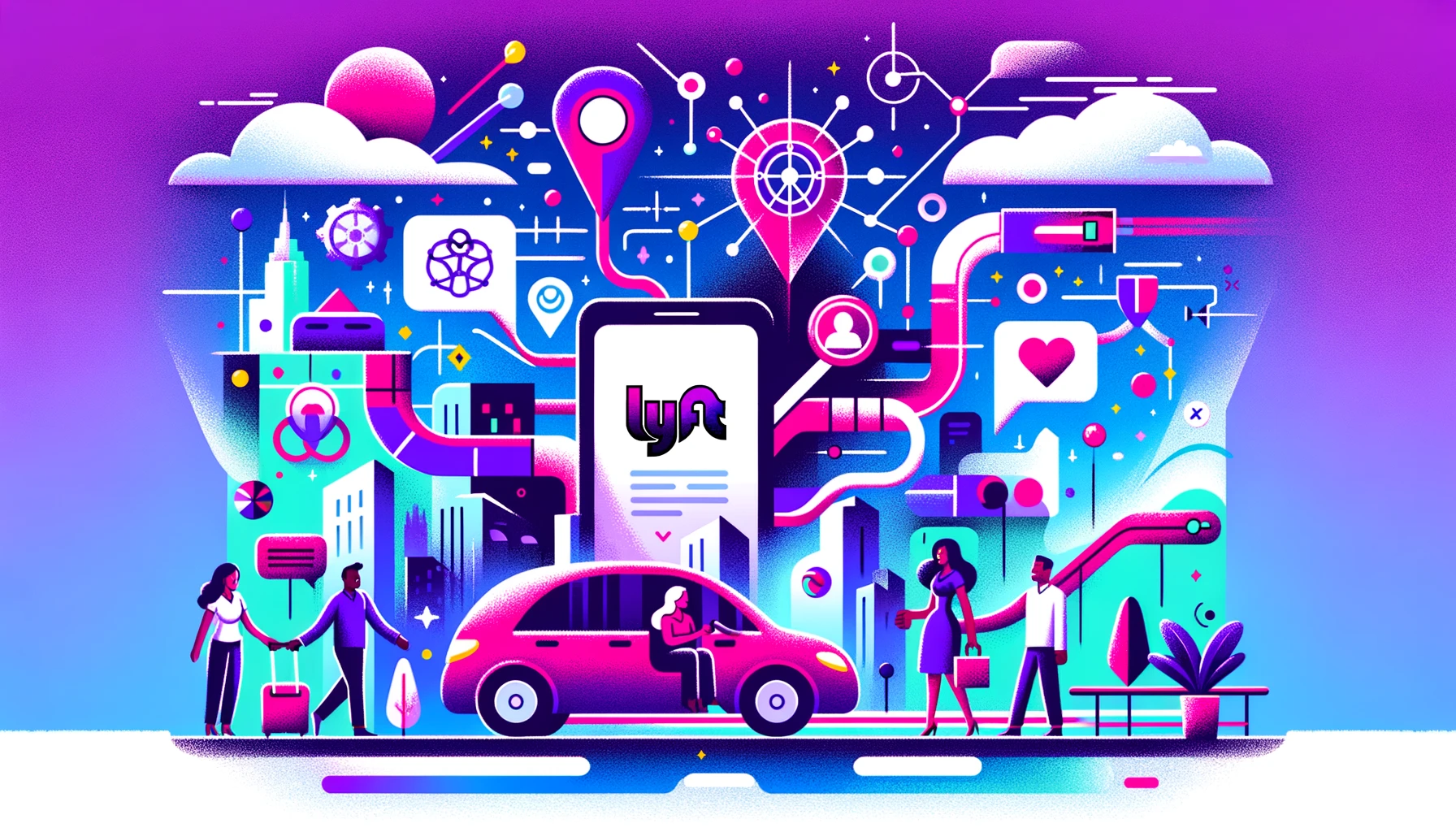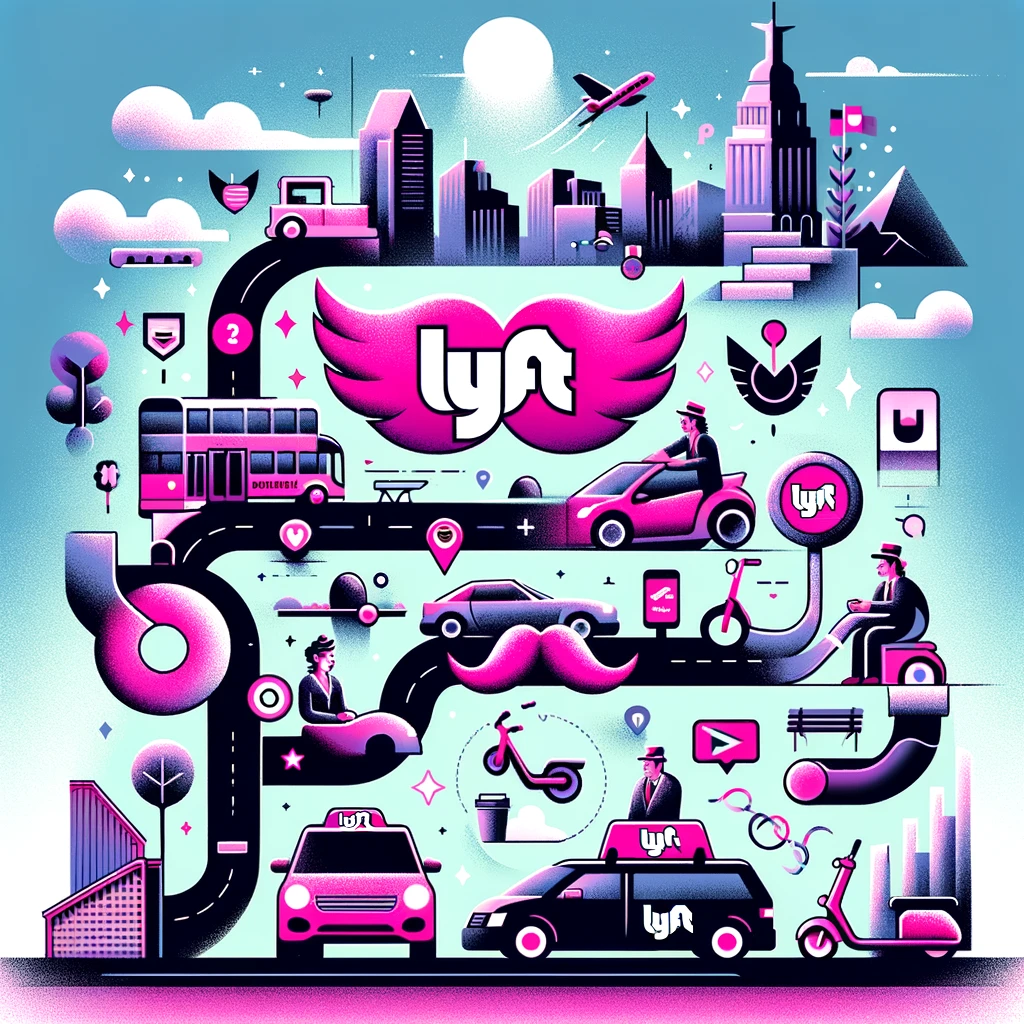Lyft marketing strategy embodies a blend of innovation, social responsibility, and customer-centric services.
Let's dive into how Lyft's strategic marketing approaches, from unique advertising campaigns to impactful social initiatives, have established Lyft as a leader in the ride-sharing industry.
Core Principles of Lyft Marketing strategy

Lyft's core core marketing strategy is centered around community engagement, user experience, and brand differentiation.
Lyft’s approach reflects a keen understanding of the ride-sharing market's dynamics and consumer expectations, drawing parallels with luxury marketing principles in its focus on customer satisfaction and brand loyalty.
Community Engagement
Lyft distinguishes itself through a strong emphasis on building a community-centric brand.
The company fosters a sense of belonging and inclusivity among its users and drivers, akin to the exclusivity and club-like feeling associated with luxury brands.
Lyft has initiated various partnerships with local businesses and events to embed itself within the communities it serves, offering discounted rides to promote responsible drinking or support local festivals.
One campaign that exemplifies Lyft's marketing savvy is the "Round Up & Donate" feature, enabling riders to elevate their fare to the nearest dollar, with the surplus going to a chosen charity. This initiative prominently highlights Lyft's commitment to community engagement, resonating deeply with consumers who prioritize social responsibility.
Lyft's strategy not only enhances brand visibility but also strengthens customer loyalty through shared values and experiences.
User Experience
Prioritizing user experience is at the heart of Lyft's marketing approach.
Lyft invests in technology and design to ensure a seamless and comfortable ride from start to finish similar to how luxury brands focus on delivering impeccable service and personalized experiences.
Features like in-app suggestions for pickup points, real-time tracking of rides, and the ability to schedule rides in advance are tailored to enhance convenience and reliability.
Lyft’s commitment to safety through background checks and in-ride features like emergency assistance mirrors the meticulous attention to customer care seen in high-end markets.
User Experience is a cornerstone of Lyft's marketing strategy, focusing on customer satisfaction and engagement.
A notable example of Lyft's user experience strategy is the introduction of in-car tablets. These devices provide passengers with entertainment, ride information, and the ability to control in-ride features, thereby elevating the comfort and personalization of each journey.
Brand Differentiation
Lyft's marketing strategy is also characterized by its efforts to differentiate itself from competitors through a unique brand identity.
Emphasizing a friendly, approachable image highlighted by the distinctive pink mustache in its early days, Lyft positions itself as more than just a ride-sharing service; it's a supportive and joyful community.
Campaigns and ads that feature real stories from Lyft drivers and passengers reinforce this image, creating an emotional connection with the audience.
Lyft's strategy resembles how luxury brands leverage their heritage and storytelling to create a distinct brand persona.
From Start-Up to Industry Leader: Lyft's Journey

The history of Lyft as a company showcases its journey from a startup to a major player in the ride-sharing industry. Founded in 2012, Lyft began as a service offering rides in a unique, pink-mustached fleet, symbolizing a friendly, community-driven approach.
Rapidly expanding its footprint in new markets, Lyft emphasized user experience and safety, distinguishing itself with stringent driver vetting and innovative features like in-app payment and real-time tracking.
By focusing on urban mobility solutions, Lyft app evolved to include bike-sharing, scooter rentals, and carpool options, catering to diverse transportation needs.
Its commitment to sustainability and a vision for a less congested future propelled Lyft into a leading position, competing head-on with rivals and changing the way cities move.
Target Market Analysis
Lyft focuses on urban dwellers, young professionals, and tech-savvy individuals seeking convenient, affordable, and reliable transportation options. This demographic values the ease of use provided by the Lyft mobile app, which simplifies booking rides and offers transparent pricing.
Lyft targets environmentally conscious consumers who prefer ridesharing over owning a vehicle to reduce their carbon footprint. The company's commitment to sustainability and initiatives for green transportation resonate with this segment.
Lyft appeals to budget-conscious business travelers and commuters who find ridesharing a cost-effective alternative to traditional taxis and public transportation.
By understanding the preferences and needs of these key segments, Lyft tailors its marketing and advertising messages to highlight convenience, affordability, community, and environmental responsibility.
Through targeted campaigns and partnerships, Lyft not only attracts but retains customers by offering loyalty programs and discounts, further cementing its position in the competitive ridesharing market.
Lyft Marketing Mix
Lyft's marketing mix is a strategic blend of product, price, place, and promotion, tailored to position Lyft as a leading ride-sharing service that prioritizes accessibility, sustainability, and community engagement.
Product Strategy
Lyft offers a wide range of services designed to meet various customer needs, including personal rides, shared rides (Lyft Line), luxury rides (Lyft Lux), and even bike and scooter rentals in certain areas.
The company focuses on convenience, safety, and a positive user experience, integrating advanced technology into its app to ensure ease of use, such as real-time tracking, seamless payment systems, and safety features like emergency assistance and ride verification.
Price Strategy
Lyft employs competitive pricing to attract and retain users, offering various discounts and promotional codes for new and existing customers.
Dynamic pricing during peak times balances supply and demand, ensuring availability.
Lyft's pricing strategy also includes affordable ride options like Lyft Shared, which provides cost-effective solutions for budget-conscious consumers.
Place Strategy
Lyft operates in numerous cities across the United States and has expanded internationally, offering a broad geographic coverage to meet the mobility needs of urban and suburban populations.
The digital nature of Lyft's service platform allows for seamless accessibility through its mobile app, enabling users to book rides from virtually any location within the service areas.
Promotion Strategy
Lyft's promotional activities leverage social media, partnerships, and referral programs to increase brand awareness and expand its user base.
- Referral Programs: Lyft encourages users to refer friends to the service by offering ride credit to both the referrer and the new user, fostering organic growth.
- Partnerships: Collaborations with popular brands and events offer exclusive benefits to Lyft users, such as discounted rides to festivals and markets or rewards points for airline miles. Strategic partnerships with companies like Starbucks and Delta Airlines offer mutual benefits and enhance customer incentives.
- Community Initiatives: Lyft's "Round Up & Donate" feature allows riders to round up their fare to the nearest dollar and donate the difference to a charity of their choice, aligning with the values of socially conscious consumers.
In select cities, Lyft adapted nimbly to the challenges posed by the COVID-19 pandemic through the launch of LyftUp. This significant effort provided essential support by offering complimentary or reduced-price rides to essential workers and underprivileged individuals needing transportation to vaccination appointments.
Such actions not only underscored Lyft's dedication to societal welfare but also reinforced brand allegiance among its user base, while attracting positive media spotlight and interest from prospective customers.
Lyft Brand Campaigns: Driving Change Beyond Transportation

Lyft's brand campaigns are strategically designed to forge meaningful connections with their target audience. Through innovative storytelling and relatable messaging, Lyft aims to position itself as more than just a ride-sharing app and service but as a lifestyle brand that resonates with its users on a personal level.
Human-Centric Approach
Lyft's advertising strategy places a strong emphasis on human-centric narratives, showcasing real stories of drivers and passengers.
Highlighting the diverse backgrounds and experiences of hundreds of millions of individuals using Lyft, the company fosters a sense of community and inclusivity.
Lyft's "Undercover Lyft" campaign, where celebrities disguise themselves as Lyft drivers in app ads, not only generates buzz but also humanizes the brand by showcasing genuine interactions between drivers and passengers.
Social Impact Initiatives
Social Impact Initiatives are a cornerstone of Lyft's marketing strategy, showcasing the company's dedication to fostering positive change within communities.
By integrating these initiatives into their advertising business, Lyft not only promotes its services but also aligns itself with broader social values and causes.
This approach not only enhances the brand's image but also strengthens its connection with consumers who value corporate responsibility.
Advertising Strategy: Targeted Messaging
Lyft's advertising strategy revolves around delivering targeted messages that resonate with specific segments of their audience. Through data-driven insights and personalized content, Lyft ensures that its marketing efforts effectively reach and engage potential customers.
A notable example is Lyft's partnership with Universal Pictures for the movie release of "The Secret Life of Pets," where they launched a themed marketing initiative featuring branded cars and exclusive content. This campaign effectively leveraged pop culture to engage customers, showcasing Lyft's innovative approach to embedding its brand within universally appealing narratives
Geo-Targeting
Utilizing geolocation data, Lyft delivers tailored advertisements to users based on their location, allowing for hyper-localized campaigns that speak directly to the needs and preferences of millions of individuals in different areas.
During major events or festivals, Lyft may run promotions or sponsorships targeting attendees, offering discounts or special services to attract riders during peak times.
Segmented Marketing
Lyft crafts customized marketing messages by segmenting its audience based on demographics, interests, and behavior, that address the unique motivations and concerns of different user groups
This approach allows Lyft to effectively communicate its value proposition to diverse segments of the market.
For example, advertisers leverage social media trends and influencers to amplify their message, effectively engaging with younger demographics who value social responsibility and digital connectivity.
Conclusion
Key takeaways from Lyft's Marketing Strategy
- Innovation and Customer Focus: Lyft's marketing strategy thrives on innovation and a deep focus on customer experience, leveraging technology and personalized services to meet and exceed user expectations.
- Community and Social Responsibility: Central to Lyft's strategy is the emphasis on community engagement and social responsibility, with initiatives designed to promote inclusivity, sustainability, and support for local communities.
- Brand Differentiation through Values: Lyft differentiates itself in the competitive ride-sharing market by not only offering convenient and reliable transportation solutions but also by aligning its brand with values that resonate with consumers, such as social impact and environmental consciousness.
FAQs on Lyft's marketing Strategy
What is the marketing strategy of Lyft?
Lyft's marketing strategy focuses on innovation, social responsibility, and enhancing the customer experience. It emphasizes community engagement, user satisfaction, and brand differentiation to stand out in the ride-sharing market. Through targeted advertising campaigns, partnership initiatives, and a commitment to social causes, Lyft aims to foster a loyal customer base and drive growth.
What is Lyft's competitive advantage?
Lyft's competitive advantage lies in its strong brand identity, which is rooted in community and inclusivity. Unlike its competitors, Lyft prioritizes a friendly, approachable image and invests heavily in safety and user experience. Its unique campaigns and social initiatives resonate with consumers, further distinguishing Lyft in the competitive landscape.
What is the growth strategy of Lyft?
Lyft's growth strategy includes expanding its service offerings, entering new markets, and leveraging technology to enhance the ride-sharing experience. By focusing on sustainability, Lyft aims to attract environmentally conscious consumers. Strategic partnerships and innovative marketing tactics also play a crucial role in Lyft's efforts to increase market share and user engagement.
Who is Lyft's target market?
Lyft targets urban dwellers, young professionals, and tech-savvy individuals who seek convenient, affordable, and reliable transportation options. It also appeals to environmentally conscious consumers and budget-minded business travelers. By understanding the preferences of these segments, Lyft tailors its services and marketing messages to meet their specific needs.


 Entrepreneurship
Entrepreneurship

